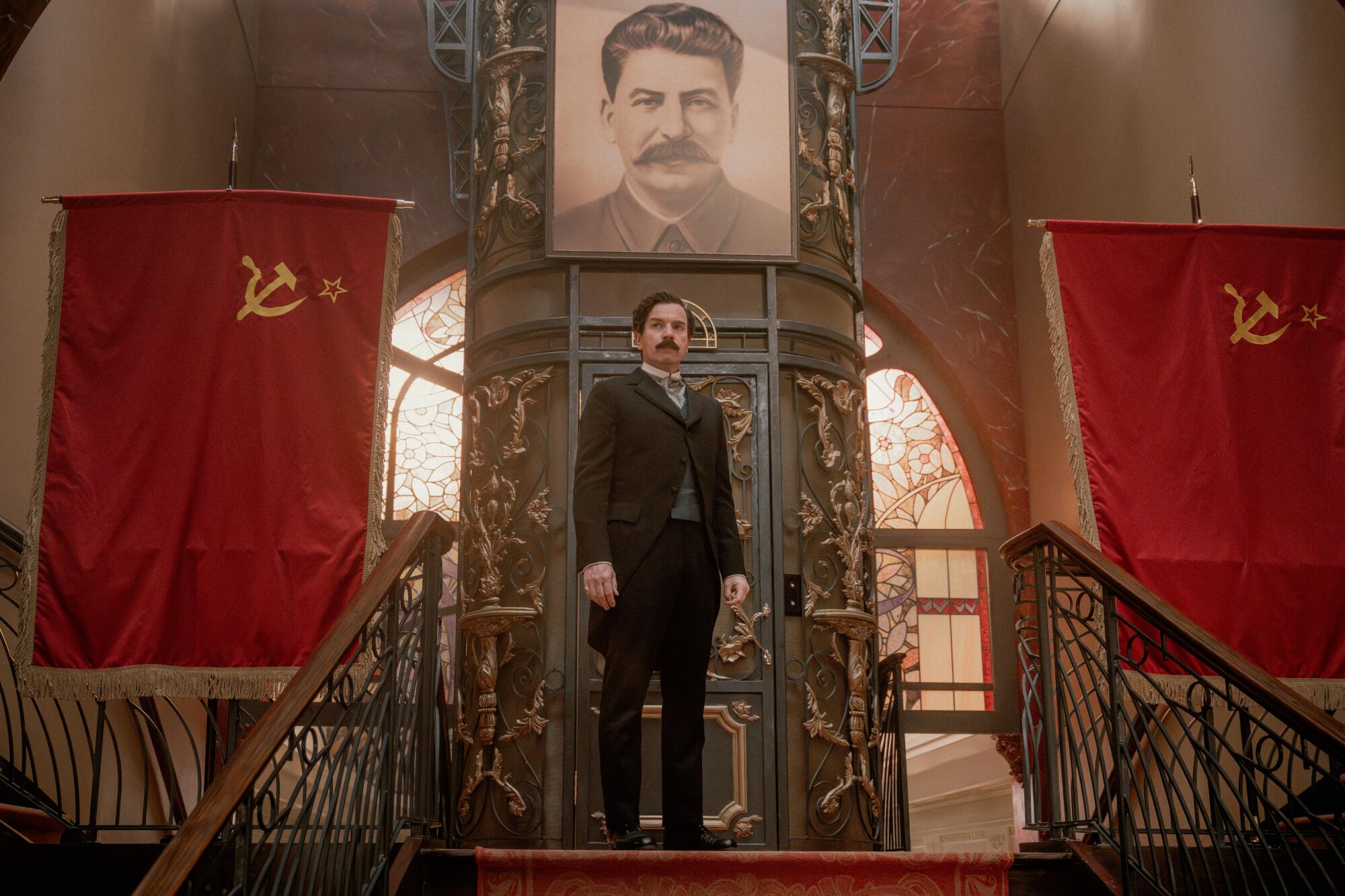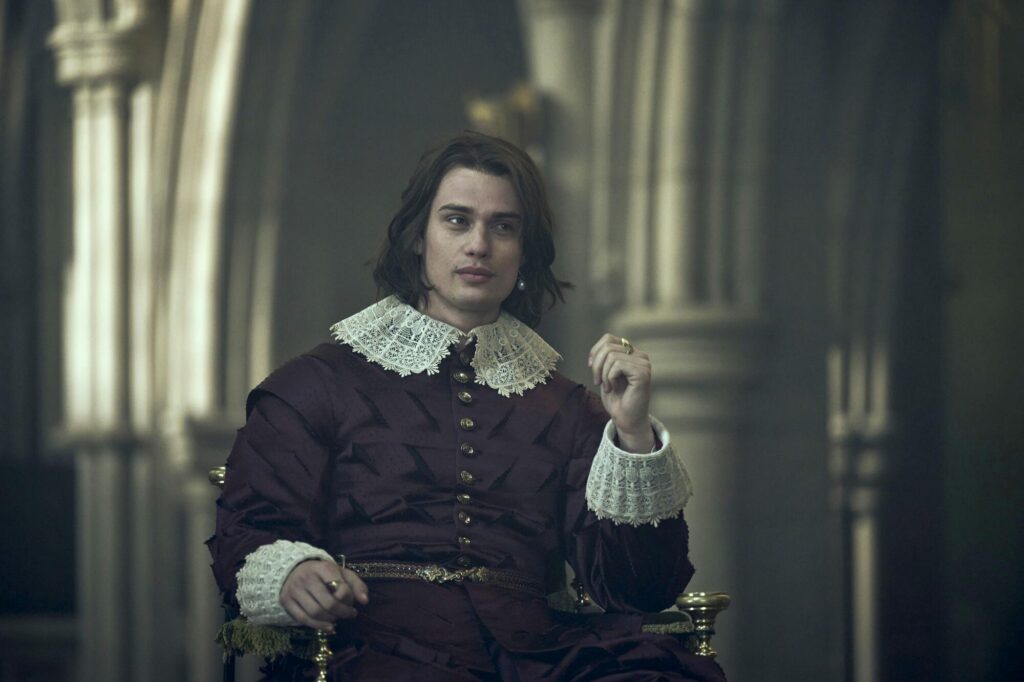Apple TV+ continues to build its library of historical dramas, adding the 18th century-set “Franklin” and conspiracy thriller “Manhunt” to its spring offerings. With stories occurring nearly 100 years apart, the two titles share an affinity for power dressing. On Starz, “Mary & George” underscores how alluring clothing can help woo a Jacobean king, and Paramount+ With Showtime keeps up the sartorial flourishes with the 30-plus-year-spanning “A Gentleman in Moscow,” which opens in 1920s Russia.
Corsets and gorgeous gowns have long dominated the period costume design conversation. But in 2024, turning back the clock showcases how menswear is pulling focus. Here, costume designers Annie Symons (“Mary & George”), Olivier Bériot (“Franklin”), Katie Irish (“Manhunt”) and Sam Perry (“A Gentleman in Moscow”) discuss attention-grabbing masculine attire across four separate centuries.
George Villiers (Nicholas Galitzine) gets glammed up in Starz’s “Mary & George.”
(Rory Mulvey/Starz)
Rather than pushing her daughter toward a wealthy suitor, Mary Villiers (Julianne Moore) wields her son, George (Nicholas Galitzine), like a dazzling weapon to get close to King James I (Tony Curran). First, Mary sends an unrefined George, wearing drab brown, to France in 1612 to learn how to be a gentleman. “When George comes back, he’s haute fashion, beyond fashion. All the other boys are wearing a mishmash of Elizabethan or early Jacobean,” says Symons.
A seductive dance in a see-through embroidered shirt, crimson ruff and gold leather belt allows George to beguile the king. Director Oliver Hermanus “was very keen that we see the masculine form, particularly through these fine fabrics, and there is a great sensuality about that,” adds Symons. “It’s suggestive, not explicit, and I think these fabrics are very beautiful and move well.” King James’ penchant for attractive men and jewels was not a secret, with George welcoming such symbols of “power, money, swag” as lace and pearls. “A single pearl [earring] is synonymous with the age. I think it was a good look. I know Nick rather likes it, and Tony rather likes it, and according to TikTok, they’ve all gone bonkers for it.”
George Villiers is far from alone in getting a wardrobe upgrade in France. Skip to 1776, when 17-year-old Temple Franklin (Noah Jupe) travels with his grandfather, Benjamin Franklin (Michael Douglas), to Paris to secure support against the British. In an act of adolescent rebellion, Temple follows the French aristocratic trends favored by his new friends, like soon-to-be war hero Lafayette (Théodore Pellerin). “Temple embraced the chic of these guys. We buy this fabric, which is a silk with the design in it — very rich type of silk from Lyon — to show how he tried to look different from his grandfather,” Bériot says.
Bériot presented veteran TV director Tim Van Patten with mood boards featuring paintings from the eight years the Franklins spent in France, alongside an image from a contemporary collection. “For the grandson, I looked at a big fashion brand like Balmain for H&M, and I do a parallel between a painting of that period and this look to give a feeling of today,” Bériot says. Although Temple’s closet gets an overhaul, green is an anchoring shade as it matches the only color painting of the young man.

Ewan McGregor as Count Rostov in “A Gentleman in Moscow.”
(Ben Blackall/Paramount+ with Showtime)
In what’s referred to as the “Pretty Woman” scene, Temple undergoes a classic teen makeover in the first episode. “I push each character a little bit to be more fun because I think it’s a fun moment in the story, and it was fun to do,” Bériot notes. Think gender fluidity is a modern phenomenon? Not so, Symons says. “Jacobean style as menswear was becoming feminized in many ways,” but French fashion in the 1770s turned the gender fluidity dial further.
Unlike George and Temple, actor and assassin John Wilkes Booth (Anthony Boyle) eschews color in “Manhunt.” Set in the lead-up to and aftermath of President Lincoln’s assassination, Booth favors statement pieces such as a black felt slouch hat. “I think it shows Booth’s flair because it’s so different from the everyday kind of hats that we see that he stands out in a crowd,” Irish says. Other affectations such as Booth’s cravat pin, pinkie ring and monogrammed leather boots add to his carefully curated image.
As with “Manhunt,” Count Alexander Ilyich Rostov (Ewan McGregor) in “A Gentleman in Moscow” wears a monogrammed signet ring as part of his style identity. “I’ve had people look at me like I’m crazy when I say that I love menswear because it seems like such a staid and rigid set of rules,” Irish says. “But there are so many little choices within them that you can personalize it that way.”
The 2024 award season showed an uptick in brooches and lapel pins worn by men, harking to the 19th century. “One of the things about this specific period of Victorian menswear is it is a ‘more is more’ period when men had tons of jewelry available to them if you could afford it,” Irish adds.

Brandon Flynn, left, and Tobias Menzies in Apple TV’+s “Manhunt.”
(Chris Reel)
Look closely at “Manhunt”: Wolf imagery appears in Secretary of War Edwin Stanton’s (Tobias Menzies) accessories. Lincoln nicknamed Stanton “Mars,” and the animal associated with the Roman god of war was the wolf. “We made some custom buttons that had wolves on them based on some we had found in research,” Irish says. “My props master came through and had the most beautiful watch fob with the head of a wolf on it.” Intricately embroidered custom waistcoats signify wealth, highlighting Stanton’s mood and allegiance through shades of blue: “There is a bit of a peacock aspect just in being very proud of what he and Lincoln have accomplished.”
Leadership values change, but being placed under permanent house arrest by the Bolsheviks at the luxury Hotel Metropol in “A Gentleman in Moscow” doesn’t stop Alexander from dressing the aristocratic part. “We started with him being more peacocky, so full of himself and a big contrast to what was going on in the rest of Russia,” Perry says. “We had the most matching socks and handkerchiefs — all the details.”
Given that Alexander no longer has the option (or finances) to venture to London or Paris, it helps that the count’s footwear is of excellent quality. “Dressing up with your shoes became redundant after he’d been there for a while, but they were well-made, good things, and he wouldn’t throw them away,” Perry notes.
Alexander’s romance with movie star Anna Urbanova (Mary Elizabeth Winstead) gives the former count a run for his sartorial money. “They’re both at their most peacocky and glamorous when they fall in love, and they grow together as a couple,” the costume designer adds. “I thought that was lovely to do with knitwear and a softening of fabrics — using different flannels toward the 1940s and ’50s.” Priorities evolve, jacket lengths rise and fall and formalwear is seen less frequently, but attention to detail remains.
Undoubtedly, playful menswear that doesn’t recede into the background is in vogue on TV and the red carpet. “It goes in and out of fashion throughout the decades or centuries,” says Symons. “I think it’s having another renaissance.”

